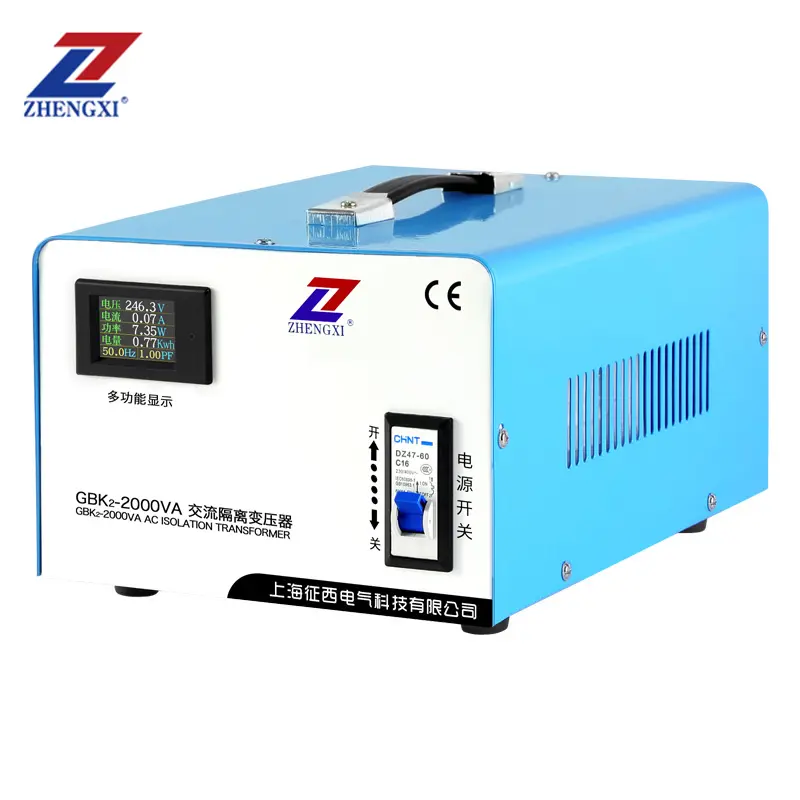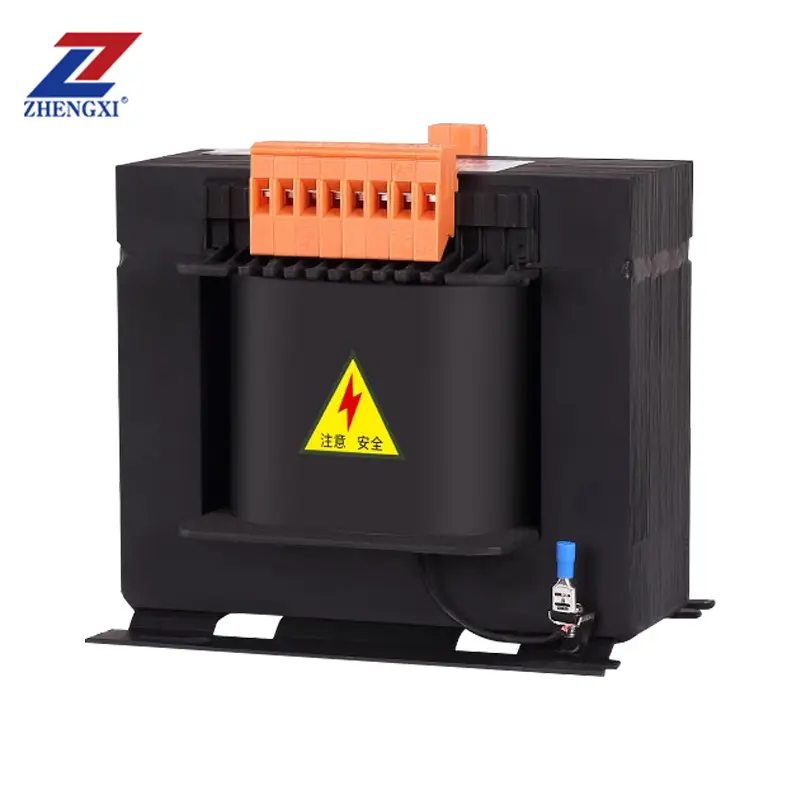Les transformateurs de commande sont des composants essentiels utilisés dans les systèmes de commande électrique, fournissant la tension nécessaire à divers dispositifs tels que les relais, les contacteurs et les circuits de commande. Ils sont spécialement conçus pour garantir que la tension correcte est fournie aux composants de commande des machines et des équipements. Dans ce blog, nous allons explorer les principales caractéristiques, les types, les applications et les avantages des transformateurs de commande, et répondre à quelques questions fréquemment posées pour vous aider à prendre une décision éclairée lorsque vous en choisirez un.
Qu'est-ce qu'un transformateur de contrôle ?
Un transformateur de commande est un type de transformateur utilisé pour fournir une tension de sortie spécifique pour les circuits de commande dans les applications industrielles et commerciales. Contrairement aux transformateurs standard, qui augmentent ou diminuent la tension pour les circuits d'alimentation, les transformateurs de commande sont généralement conçus pour fournir des niveaux de tension inférieurs aux dispositifs de commande, garantissant ainsi un fonctionnement sûr et efficace.



Caractéristiques principales des transformateurs de contrôle
- Régulation de la tension: Les transformateurs de commande sont conçus pour maintenir une tension de sortie stable malgré les variations de la tension d'entrée. Cela garantit un fonctionnement fiable des dispositifs de contrôle, même lorsque la tension d'alimentation fluctue.
- L'isolement: Les transformateurs de commande assurent l'isolation électrique entre le circuit de commande et le circuit d'alimentation, améliorant ainsi la sécurité en évitant les chocs électriques accidentels et en minimisant le risque d'endommager les composants sensibles.
- Taille compacte: Les transformateurs de commande sont généralement plus petits et plus légers que les transformateurs de puissance, ce qui les rend idéaux pour les applications où l'espace est limité.
- Capacité multi-tap: De nombreux transformateurs de commande comportent plusieurs prises sur le côté secondaire, ce qui permet aux utilisateurs de sélectionner différentes tensions de sortie en fonction des exigences spécifiques de leurs circuits de commande.
- Protection contre les surcharges: Les transformateurs de commande sont souvent équipés d'une protection intégrée contre les surcharges afin d'éviter les dommages dus aux courts-circuits ou aux conditions de charge excessive.
Types de transformateurs de contrôle
- Transformateurs de commande abaisseurs: Ces transformateurs réduisent la tension d'entrée à un niveau inférieur, plus approprié pour le circuit de commande. Par exemple, ils peuvent réduire une entrée de 480V ou 240V à une sortie de 120V ou 24V.
- Transformateurs de contrôle élévateurs: Ces transformateurs augmentent la tension d'entrée à un niveau plus élevé pour alimenter les appareils qui nécessitent des tensions plus élevées pour fonctionner.
- Transformateurs d'isolation: Ces transformateurs sont conçus pour isoler le circuit de commande de l'alimentation principale, ce qui renforce la sécurité et la protection des équipements de commande sensibles.
- Auto-Transformateurs: Un auto-transformateur est un transformateur qui partage un enroulement commun pour les côtés primaire et secondaire. Il est souvent utilisé pour la régulation de la tension et les applications à haut rendement énergétique.
Applications des transformateurs de contrôle
Les transformateurs de contrôle sont largement utilisés dans diverses industries, notamment la fabrication, l'automatisation, les systèmes de chauffage, de ventilation et de climatisation, etc. Parmi les applications les plus courantes, on peut citer
- Machines industrielles: Les transformateurs de commande sont utilisés pour alimenter les circuits de commande de machines telles que les convoyeurs, les grues et les lignes de production automatisées.
- Systèmes CVC: Dans les systèmes de chauffage, de ventilation et de climatisation, les transformateurs de commande régulent la tension pour les thermostats, les panneaux de commande et d'autres composants.
- Contrôle de l'éclairage: Les transformateurs de contrôle peuvent être utilisés dans les systèmes de contrôle de l'éclairage, assurant des niveaux de tension appropriés pour les relais et les interrupteurs.
- Systèmes d'alarme et de sécurité: Les transformateurs de contrôle fournissent l'énergie nécessaire aux panneaux de contrôle, aux capteurs et aux alarmes des systèmes de sécurité.
Avantages des transformateurs de contrôle
- Sécurité: En assurant l'isolation électrique et en régulant la tension, les transformateurs de commande protègent les équipements sensibles et le personnel contre les risques électriques.
- Efficacité: Ils garantissent que les dispositifs de contrôle reçoivent la tension correcte, ce qui améliore l'efficacité de l'ensemble du système.
- Longévité: Une bonne régulation de la tension réduit l'usure des composants de contrôle, prolongeant ainsi la durée de vie du transformateur et des appareils connectés.
FAQ : Questions fréquemment posées sur les transformateurs de contrôle
1. Quelle est la fonction principale d'un transformateur de contrôle ?
Un transformateur de commande est utilisé pour fournir une tension stable et régulée aux circuits de commande dans les applications industrielles et commerciales, garantissant que les dispositifs de commande tels que les relais et les contacteurs fonctionnent de manière sûre et efficace.
2. En quoi un transformateur de commande diffère-t-il d'un transformateur de puissance ?
Un transformateur de puissance est conçu pour élever ou abaisser la tension des circuits de puissance, tandis qu'un transformateur de commande est spécifiquement conçu pour fournir des tensions plus basses et plus précises aux circuits de commande, en assurant l'isolation et la protection des composants sensibles.
3. Puis-je utiliser un transformateur standard au lieu d'un transformateur de contrôle ?
Il n'est pas recommandé d'utiliser un transformateur standard pour les circuits de commande, car il n'offre pas le même niveau de régulation de la tension et d'isolation électrique que celui requis pour les composants de commande sensibles. Les transformateurs de contrôle sont spécifiquement conçus pour répondre à ces besoins.
4. Quelle est la tension nominale d'un transformateur de commande ?
Les transformateurs de commande sont disponibles dans différentes tensions nominales, fournissant généralement des tensions de sortie de 120V, 24V ou 48V. La tension nominale doit correspondre aux exigences du circuit de commande pour garantir un fonctionnement correct.
5. Les transformateurs de commande sont-ils efficaces sur le plan énergétique ?
Oui, les transformateurs de commande sont conçus pour être efficaces sur le plan énergétique en fournissant la tension correcte pour les circuits de commande. Leur taille compacte et leur conception efficace permettent de réduire les pertes d'énergie par rapport aux transformateurs de puissance plus importants.
6. Comment choisir le transformateur de commande adapté à mon application ?
Lors de la sélection d'un transformateur de commande, vous devez tenir compte de facteurs tels que la tension d'entrée, la tension de sortie requise, la puissance nominale (KVA) et le type de circuit de commande. Il est essentiel de faire correspondre les spécifications du transformateur aux besoins de votre équipement afin de garantir des performances et une sécurité optimales.
7. Quelle est la différence entre un transformateur de contrôle élévateur et un transformateur de contrôle abaisseur ?
Un transformateur de commande abaisse la tension d'entrée à un niveau inférieur, tandis qu'un transformateur élévateur augmente la tension d'entrée à un niveau supérieur. Le type de transformateur dont vous avez besoin dépend des exigences de tension de votre circuit de commande.
8. Les transformateurs de contrôle peuvent-ils supporter des surcharges ?
La plupart des transformateurs de commande sont équipés d'une protection contre les surcharges afin de se prémunir contre les courts-circuits ou les conditions de charge excessive. Toutefois, il est essentiel de choisir un transformateur d'une puissance nominale suffisante pour votre application spécifique afin d'éviter les problèmes de surcharge.
9. Comment installer un transformateur de contrôle ?
L'installation d'un transformateur de commande doit être effectuée par un électricien qualifié. Il est essentiel de s'assurer que le transformateur est correctement câblé et que la tension nominale correspond aux exigences du circuit de commande.
10. Les transformateurs de commande peuvent-ils être utilisés dans des environnements extérieurs ?
Certains transformateurs de commande sont conçus pour être utilisés à l'extérieur, mais il est important de vérifier les spécifications du transformateur en ce qui concerne l'étanchéité et la protection contre les facteurs environnementaux. Pour les applications extérieures, il faut s'assurer que le transformateur est correctement enfermé et protégé des éléments.
Conclusion
Les transformateurs de commande sont des composants essentiels dans diverses applications industrielles et commerciales, assurant un fonctionnement sûr et efficace des circuits de commande. En assurant une régulation précise de la tension, une isolation électrique et une protection contre les surcharges, les transformateurs de commande protègent les équipements sensibles et améliorent les performances du système. Comprendre les différents types et caractéristiques des transformateurs de commande, et savoir comment choisir celui qui convient à vos besoins, peut vous aider à assurer la sécurité et la longévité de votre équipement. Si vous recherchez des transformateurs de contrôle fiables et de haute qualité, n'hésitez pas à nous contacter pour plus d'informations et de recommandations.

